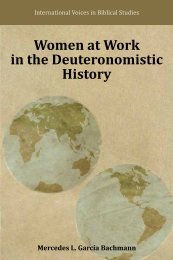The Old Testament and Christian Spirituality - International Voices in ...
The Old Testament and Christian Spirituality - International Voices in ...
The Old Testament and Christian Spirituality - International Voices in ...
Create successful ePaper yourself
Turn your PDF publications into a flip-book with our unique Google optimized e-Paper software.
98 <strong>The</strong> <strong>Old</strong> <strong>Testament</strong> <strong>and</strong> <strong>Christian</strong> <strong>Spirituality</strong><br />
<strong>in</strong>troduced to the reader, rather than the ma<strong>in</strong> genealogical l<strong>in</strong>e<br />
only).<br />
A note on each of these four narrative <strong>in</strong>terpolations to this<br />
otherwise tightly structured genealogy, is <strong>in</strong> order:<br />
1 P, here as <strong>in</strong> Gen 1, offers a re<strong>in</strong>terpretation of J’s creation<br />
narrative, <strong>in</strong> this case emphasis<strong>in</strong>g God’s bless<strong>in</strong>g of the<br />
generations, which <strong>in</strong>cludes, implicitly, both the multiplication<br />
itself (Gen 5:2) <strong>and</strong>, explicitly, the <strong>in</strong>dication that creation <strong>in</strong><br />
God’s image (cf. Gen 1:26–27) is cont<strong>in</strong>ued <strong>in</strong>to the next<br />
generation/s (Gen 5:3). This, Wilson argues, is a decidedly<br />
more positive view than J’s switch between s<strong>in</strong> <strong>and</strong> grace. 60<br />
2 It does not seem necessary to attribute 5:24 to a non-P h<strong>and</strong><br />
because of stylistic reasons, that is, because of its narrative<br />
nature: the usual structure of the Gen 5 genealogical notes<br />
rema<strong>in</strong>s <strong>in</strong>tact here; the�tmoY"w:-note is merely replaced by what<br />
the tradition regard<strong>in</strong>g Enoch had to offer <strong>in</strong> its place. Neither<br />
does the theological st<strong>and</strong> <strong>in</strong>dicate a h<strong>and</strong> other than P.<br />
Enoch’s be<strong>in</strong>g taken by God without dy<strong>in</strong>g differs from<br />
Sumerian <strong>and</strong> Akkadian parallels <strong>in</strong> the theologically important<br />
respect that it is God who is the subject of the action here. 61<br />
This accords well with a broader theme <strong>in</strong> P, of God provid<strong>in</strong>g<br />
certa<strong>in</strong> pious men. This theme has as its purpose the<br />
encouragement of the exilic community to whom P is<br />
addressed. 62<br />
3 Vermeylen proposes that 5:28b–29 should be read <strong>in</strong> direct<br />
cont<strong>in</strong>uation of 4:26. 63 <strong>The</strong> content of 5:28b–29 certa<strong>in</strong>ly<br />
60<br />
Wilson, Genealogy <strong>and</strong> History <strong>in</strong> the Biblical World, 163–64.<br />
61<br />
See A. Schmit, “Zum <strong>The</strong>ma ‘Entruckung’ im Alten <strong>Testament</strong>,” Biblische<br />
Zeitschrift 26 (1982): 41.<br />
62<br />
Ibid., 43–44.<br />
63<br />
Vermeylen, “La Descendance de Caïn et le Descendance d’Abel,” 177–78. If<br />
this attractive proposal is generally accepted, it would force the re-exam<strong>in</strong>ation<br />
of a great many analyses of the depth (“how many generations?”) <strong>and</strong> number




